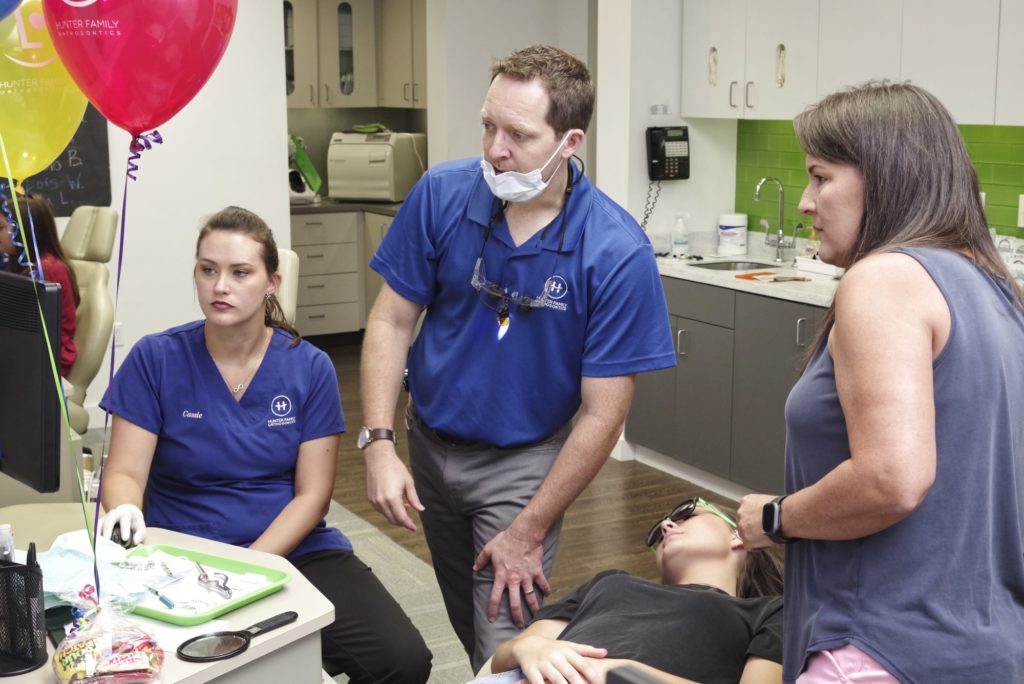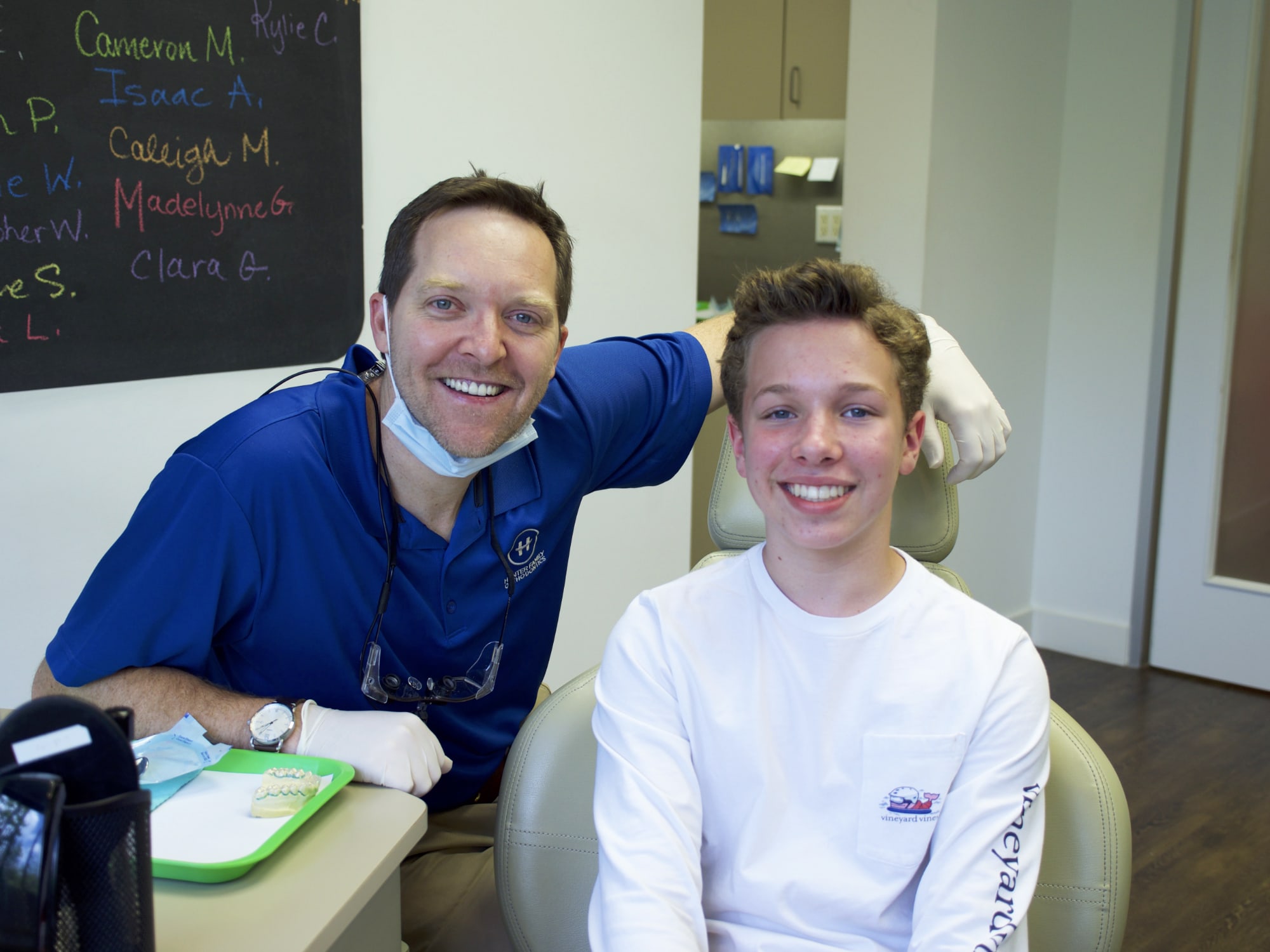Stereotypes can be powerful things, which is why you probably picture a teenager in full metal braces whenever you hear the word orthodontics. While this particular stereotype has proven to have a lot of staying power, orthodontics can actually be beneficial to patients of all ages, including children. That’s why the American Association of Orthodontists recommends that kids as young as 7 have an orthodontic evaluation!
Since children this age have developing mouths and a number of baby teeth, you may wonder why they would need to see an orthodontist so soon. This is part of the preventative approach Hunter Family Orthodontics takes to orthodontic care. When you schedule an early exam with an experienced orthodontist like Dr. Hunter, there’s a much better chance of catching any existing or potential orthodontic issues sooner rather than later. This reduces the risk of those problems becoming a bigger deal later on in life, helping to prevent any negative impact on their future permanent teeth and bite.
Our practice treats many younger patients, and this has allowed us to observe firsthand how starting treatment at the right time can positively impact a child’s overall oral health. If you have a child around the age of 7 who is ready for their first orthodontic appointment, we’d love to meet you both and take a look at how their mouth is developing! Keep reading below to learn more about some of the things Dr. Hunter will be checking for during this initial evaluation.
Tooth loss and eruption
As placeholders for the permanent teeth, baby teeth are important, even though they eventually fall out. For that reason, where they’re located and when they’re lost matters more than you may think. These primary teeth also tend to fall out in a fairly specific order. If we notice any significant deviation from that pattern, it could signify a developmental issue that needs further attention.

By this age, most children will have at least four permanent molars and up to four permanent incisors. If your child has any more or less than this, it could indicate a problem with missing, crowding, or extra teeth. In some cases, we may choose to remove a primary tooth early. In others, we may want opt to simply maintain a space where a tooth has been lost prematurely in order to prevent bigger problems later on.
Crowding and spacing
We’ll normally be able to tell fairly early on in a child’s life if they’re experiencing problems with excessive crowding or spacing of their teeth, or if problems like this are likely to develop later on. Spacing issues can show up when a tooth is lost prematurely, where one has never developed, or with teeth that are too small or spaced apart. If crowding is the main problem, it can often be corrected by expanding the arches or removing certain teeth.
Misalignment
When your teeth are crooked, it can be harder to clean them effectively. They also tend to be more susceptible to uneven damage and wear. If a misalignment is allowed to go untreated for a long enough period of time, it can compromise the surrounding gum tissue, affecting the shape and position of it. Even though we’re able to successfully align teeth at almost any age, getting a head start on correcting a misalignment can help prevent some of that wear and tear in children, giving them the best start for a healthy, happy smile!
Overbite (protrusive front teeth)
Aside from the obvious cosmetic concerns, a noticeable overbite may also cause pain in the jaw, and may even lead to difficulties with normal speech. Although we aren’t always able to permanently correct an overbite until your child’s mouth has finished growing, there are still a number of things we can do to help reduce the risk of pain and traumatic injury. This can also lead to an increase in confidence and self-esteem.
Underbite
Underbites can be caused by problems with either the teeth or the jaws. The most difficult scenario involves the lower jaw growing too far forward. In a case like that, we’ll typically need to wait until the patient has finished growing to begin their treatment. This normally occurs in their mid- to late-teens. Even so, early treatment can be important in avoiding any bite-shifting and damage to the front teeth. Underbite patients who receive early treatment between the ages of about 7-10 also to be less likely to need jaw surgery when they get older.
Posterior Crossbite
A posterior crossbite can lead to crowding, and may also cause the jaw to shift from one side to the other. Expanding the upper jaw in earlier childhood may allow us to reduce crowding and create space for the front teeth to come through uninterrupted. Expansion can also eliminate any shifting that may be present due to a constricted upper jaw.
Anterior Open Bites and Deep Bites
When a child has a deep bite, the top teeth can completely cover the bottom ones when biting, which may indicate a small lower jaw. In an open bite, the overall bite doesn’t overlap enough. This can be caused by poor oral habits, such as extended finger or thumb sucking, or if a child uses a bottle or pacifier for too long. If this is a problem you’ve experienced with your child, our team will be happy to work with both of you to help eliminate any destructive habits early on, allowing their oral development to continue normally.
Improve your child’s oral health with an early evaluation at Hunter Family Orthodontics
Early orthodontic evaluations can be an important part of giving your child the gift of a healthy smile. A child’s jaw bone hardens as they age, and eventually stops growing altogether. Orthodontic procedures that are needed after that point generally take more time and may be more invasive, like tooth extractions or oral surgery.
Having an experienced orthodontist like Dr. Hunter examine your young child can often help prevent the need for orthodontics as an adult. This kind of preventative treatment like early evaluations can also make comprehensive orthodontic treatment faster and more efficient!
Hunter Family Orthodontics is proud to provide quality orthodontic care for patients of all ages in a friendly, stress-free environment. If you’re ready to schedule your child’s first orthodontic appointment with us, get in touch with us today. We’d love to help you get started with a FREE exam!

